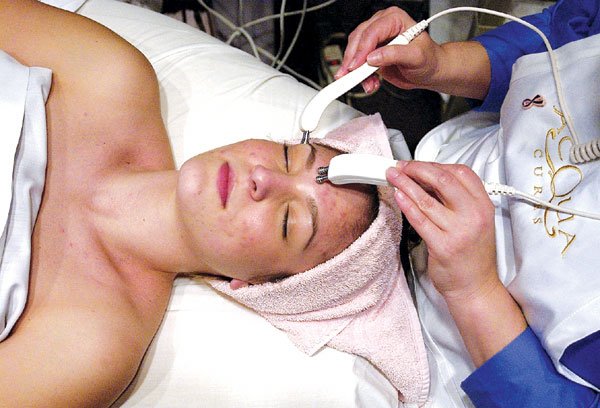The embarrassment of acne is the stuff of teen lore, but once
the magical milestone of 20 is past, few talk about the problem.
Preferring to call them bumps, blemishes, spots or imperfections,
adults sidestep the reddish spots that often reappear as hormones
fluctuate or skin becomes drier when collagen levels decline.
The embarrassment of acne is the stuff of teen lore, but once the magical milestone of 20 is past, few talk about the problem. Preferring to call them bumps, blemishes, spots or imperfections, adults sidestep the reddish spots that often reappear as hormones fluctuate or skin becomes drier when collagen levels decline.
Most adults develop acne because of clogged pores, often caused by the same moisturizers dermatologists recommend, according to University of California, Los Angeles Associate Clinical Professor Ron Moy.
“You get into a zone where people get dry, but they might be putting too much moisturizer on,” said Moy. “It’s a range they need to be careful of.”
Women and those ages 35 and over are the primary sufferers of adult-onset acne. For women, the outbreaks are generally tied to hormonal fluctuations, said Dr. Jerome Potozkin, a private practice dermatologist with offices in Danville and Walnut Creek.
These fluctuations can occur as a result of starting or stopping birth control, becoming pregnant or beginning the pre-menopausal period. Fortunately, these cases are generally light to moderate, though some adults do develop the cysts, craters and scars associated with severe acne.
For those of either sex over 35, acne rosacea is the most common type to develop, appearing as acne concentrated around the cheeks and nose, and often accompanied by redness and broken blood vessels.
The condition can also cause swelling and distortion of the face, particularly the nose.
“W.C. Fields’ nose is the worst part of middle-aged acne (rosacea),” said Moy. “Nobody really knows why it starts, but it’s a slightly different form than regular acne.”
No one is immune from adult-onset acne, but the condition is mostly genetic, according to Potozkin. Some of the world’s most beautiful and well-pampered people – stars like Brad Pitt, Cameron Diaz and Will Smith – have battled the condition under the scrutiny of the public eye. And despite the claims of late-night infomercials, there is no foolproof cure for the problem either.
“Some people – we can cure their acne,” said Potozkin. “Some people we can place in an extended state of remission, but some people just have a very, very stubborn infection.”
Fortunately, an ever-widening variety of treatment options are available for the condition.
For minor cases (those characterized mostly by the appearance of small whiteheads or blackheads with only occasional infected pores), facials and other non-medicinal options like microdermabrasion may be enough to clear up the issue, said Debra Rosas, a licensed esthetician and owner of Skin Tech in Gilroy.
For very mild cases, a deep facial cleansing and some minor extractions may be enough. Such services range from $35 to more than $150 depending on the length and level of treatment.
“For results you should probably be coming in every two weeks or every month,” said Rosas. “It’s just like going to the hairdresser or the manicurist. The skin is part of maintenance, and it’s exposed to all the elements. Microdermabrasions are going to be more aggressive. It sloughs off the dead cells so products can penetrate deeper into the skin.”
Other options include electrical treatments and laser care for acne sufferers. At Naturals Salon & Day Spa in Morgan Hill, customers can opt for the BioUltimate Facial, which shoots a low-level ionized current into the skin. They may feel a slight twinge as negative ionization helps to break down excess oils and open pores for cleaning. After cleansing, a positive ionized current helps to close pores again while also killing bacteria, said spa director Jaymie Geimer.
The treatment costs $75 for a half-hour session and $100 for a full hour. Customers should see results in six to 12 weeks with regular visits, said Geimer.
Specific areas can also be spot treated with electricity, said Rosas. For $15 she will use a wand that also contains current to dry out painfully infected pimples. Swelling is reduced within hours.
“It’s the kind of thing where if you have a big date coming up, you call,” said Rosas.
One of the most recent developments in acne treatment is that of laser or light-based technology called photodynamic therapy, said Potozkin. The treatments allow a topical acne medication, applied during the procedure, to penetrate very deeply into the skin, producing often significant results in three to six sessions, he said.
“The biggest drawback is that people really cannot go out in the sun for two days,” said Potozkin. “They can go out with a hat and sunscreen, but there should be
no direct exposure to sun. It can cause redness, burning and blistering of the skin.”
That, and the program is not covered by most insurance companies. Patients must pay $300 to $500 per treatment out of pocket.
Though the new laser treatments add to the pantheon of options, moderate to severe acne is best treated with medication. Doctors may choose to combine oral medicines like tetracycline or Accutane with topical exfoliants like Retin-A or Tazorac, said Moy, who noted that this line of treatment would be most effective for the average patient.
As to causal factors, the role of diet in acne’s appearance is still considered very controversial. Contrary to popular myth, chocolate won’t give a person pimples, said
Potozkin, and studies over the last decade have repeatedly disputed any link between diet and acne infection. However, a 2004 study suggested that over-consumption of sugars could lead to breakouts.
It is important to consult a skin care expert before beginning any new treatment. Natural or chemical products recommended for skin are the only kind that should be used. Rosas said she has seen clients who’ve taken everything from laundry detergent to dish soap and sandpaper to their own faces.











